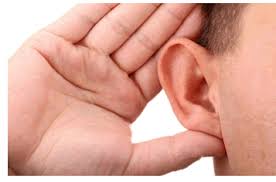 Deafness: There are two types conductive and nerve (or perceptive) D. Conductive D. results from interference to, or malfunction of, any part of the mechanism which conducts sound from the outer ear to the nerve of hearing. Damage to the ear drum, congenital abnormalities and infection or bone growth (otosclerosis) in the middle car are common causes. Destruction of cells or malformation of the cochlea (end organ of hearing), or of the auditory nerves, or of that part of the brain which interprets sound, will cause nerve D.
Deafness: There are two types conductive and nerve (or perceptive) D. Conductive D. results from interference to, or malfunction of, any part of the mechanism which conducts sound from the outer ear to the nerve of hearing. Damage to the ear drum, congenital abnormalities and infection or bone growth (otosclerosis) in the middle car are common causes. Destruction of cells or malformation of the cochlea (end organ of hearing), or of the auditory nerves, or of that part of the brain which interprets sound, will cause nerve D.
Thus meningitis, measles, mumps, scarlet fever, a fractured skull, German measles (rubella) in the mother during the 3rd to 12th week of pregnancy and hereditary factors are some common causes of nerve D. A person with a pure conductive D. is never more than 50 per cent deaf, and the condition usually responds well to medical or surgical treatment. Nerve D., however, although often quite slight, can also be profound, and at the present time there is no cure for it.
Types of Deafness
Slight conductive D is much more common than it is frequently thought to be—in ordinary schools, for example, about one child in 25, may have a significant hearing loss in one or both cars. Nerve D. is far less common—about one child in 500 is sufficiently deaf to wear a hearing aid. In adults, nerve D. becomes much more common, and the overall incidence of significant hearing loss in adults is probably about one in 20.
The degree of D present is measured with pure tone audiometers and with speech tests, and there are a tremendous number of degrees of D. Sound is measured in units called decibels normal hearing is called zero decibels, quiet voice is about 60 decibels, a shout near the car is about 100 decibels, and the threshold of pain is near 130 decibels above the normal threshold level. People whose threshold of hearing over the speech range of frequencies (500-2000 cycles per second), is between 30 and 70 decibels, may be described as partially hearing; those whose level of D. falls between 70 and 95 decibels, severely deaf, and those in excess of 95 decibels, profoundly deaf. Very few people indeed are totally deaf—perhaps one in 200,000.
Hearing aids are of use to most people who suffer from D. Those with no measurcable hearing, of course, cannot derive any benefit –except, perhaps, that if they do wear an aid, people they meet realise that they have a hearing problem, and may then take more care to speak clearly to them. A condition in adulthood, called Menitre’s disease, causes a type of D. which does not respond at all well to amplified speech. Many profoundly deaf people, however, have found that hearing aids do give them an indication of rhythm, pitch and length of words, although many of the consonant sounds (p, r, sit, s, etc.) cannot be heard at all, and all the vowels (ar, er, ee, or etc.) sound much the same—rather like a muffled ‘oo’. These very deaf people also report that their hearing aids enable them to hear a number of meaningful sounds such as doors closing, dishes rattling in the sink, the car engine, and so on—all of which help them to feel a part of their environment. Without this auditory stimulation, life becomes something like ‘living in a glass case’.
Apart from sporadic efforts by a few teachers and doctors, the problem of educating deaf children was not seriously tackled until the 18th cent. In Paris, Abbe de L’Epec began the first school for deaf children. As a result of his devoted work, and that of those who followed him, it was shown conclusively that the majority of deaf children were educable. Dc L’Epee devised a language of signs after watching the children’s natural gestures to one another.
The next major development came from Germany, where Samuel Heinicke educ. children success-fully without manual methods, and the oral system, based on lip-reading and speaking, came into existence. He founded the first public school for deaf children in Germany in 1778. Another brilliant Ger. teacher at this time was Friedrich Moritz Hill. Adaptations of the manual and the oral methods have persisted to the present day, and an approach which draws on both—’the combined system’—is used in a number of countries. .
